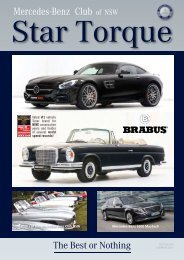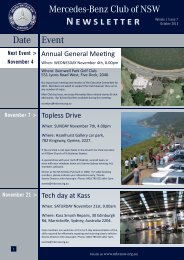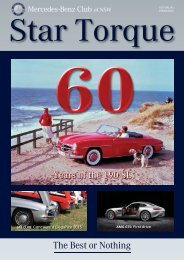You also want an ePaper? Increase the reach of your titles
YUMPU automatically turns print PDFs into web optimized ePapers that Google loves.
1992 Mercedes-Benz 350 GD Turbodiesel, short wheel base wagon 1998 Mercedes-Benz G 500, 463 series<br />
The chief designer of the G-Model<br />
was Erich Ledwinka, who had<br />
already gained a good reputation with<br />
the extremely robust, four-wheeldrive<br />
Haflinger all-terrain vehicle<br />
from Austria.<br />
Accordingly the new project was<br />
initially named H2, which stood<br />
for ‘Haflinger 2’. Since this name<br />
was too closely associated with<br />
Steyr-Daimler-Puch, the partners<br />
subsequently changed it to the simple<br />
but memorable ‘G’ for ‘Geländewagen’<br />
(off-road vehicle). At the time nobody<br />
could have predicted that this was<br />
an almost clairvoyant decision with<br />
respect to the current system of<br />
Mercedes-Benz model designations<br />
using just one letter.<br />
The first model, which was<br />
built of wood, was presented<br />
to management in 1973. The first<br />
prototype of metal construction,<br />
powered by a 2.3-litre petrol engine,<br />
was ready in September 1974.<br />
One year later, two further<br />
prototypes followed with short and<br />
long wheelbases. In 1978 a first<br />
prototype designed specifically for<br />
the military, with a fabric roof, a<br />
folding windscreen and removable<br />
doors was presented.<br />
At the time it was assumed that most<br />
of the vehicles would be equipped<br />
in this way, however, the majority<br />
of customers opted for the closed<br />
version, the station wagon.<br />
From the outset, the vehicle could<br />
be ordered with special requests, as<br />
the Mercedes-Benz G had a very wide<br />
range of applications. The designers<br />
were therefore geared toward<br />
providing individualised equipment.<br />
Production of the current<br />
G-Class in Graz commenced on<br />
1 February 1979. Daimler-Benz<br />
provided the entire drive train with<br />
its engine, transmission, axles, and<br />
steering, as well as the larger pressed<br />
components. Stamped and smaller<br />
pressed parts, as well as the transfer<br />
case, were produced by Steyr-<br />
Daimler-Puch.<br />
The range of G-models initially<br />
consisted of the 230 G (four-cylinder<br />
petrol engine, 66 kW/90 hp or 75<br />
kW/102 hp), the 240 GD (fourcylinder<br />
diesel engine, 53 kW/72 hp)<br />
and the 300 GD (five-cylinder diesel<br />
engine, 59 kW/80 hp).<br />
In early 1980 these were followed by<br />
the 280 GE (six-cylinder petrol engine<br />
with fuel injection, 110 kW/150 hp)<br />
in the low-compression version. All<br />
versions had a manual four-speed<br />
transmission and reduction gearing.<br />
The all-wheel drive with an<br />
additional cross-country ratio was<br />
able to be engaged and disengaged<br />
on the move, as were the 100-percent-locking<br />
differential locks on<br />
both rigid axles. The sophisticated<br />
suspension with trailing arms and<br />
transverse links, coil springs and<br />
shock absorbers made for excellent<br />
handling both on and off the road.<br />
Power steering was only available for<br />
the 300 GD and 280 GE as standard.<br />
Civilian customers were able to<br />
order the G as a station wagon<br />
with a short or long wheelbase, or as<br />
a convertible with a short wheelbase.<br />
There was a choice of just five paint<br />
finishes: cream white, wheat yellow,<br />
colorado beige, carmine red and<br />
agave green.<br />
For the Military there was also a<br />
long-wheelbase convertible with two<br />
or four doors. In November 1980, the<br />
range was extended with a closed<br />
box body and either a short or long<br />
wheelbase.<br />
The G-Model was not only popular<br />
with the Military, but also as a<br />
commercial vehicle, as a growing<br />
number of private customers also<br />
came to appreciate this robust offroader.<br />
They expected more comfort<br />
from such a car, however, and this<br />
was provided with the first model<br />
upgrade at the end of 1980.<br />
16







